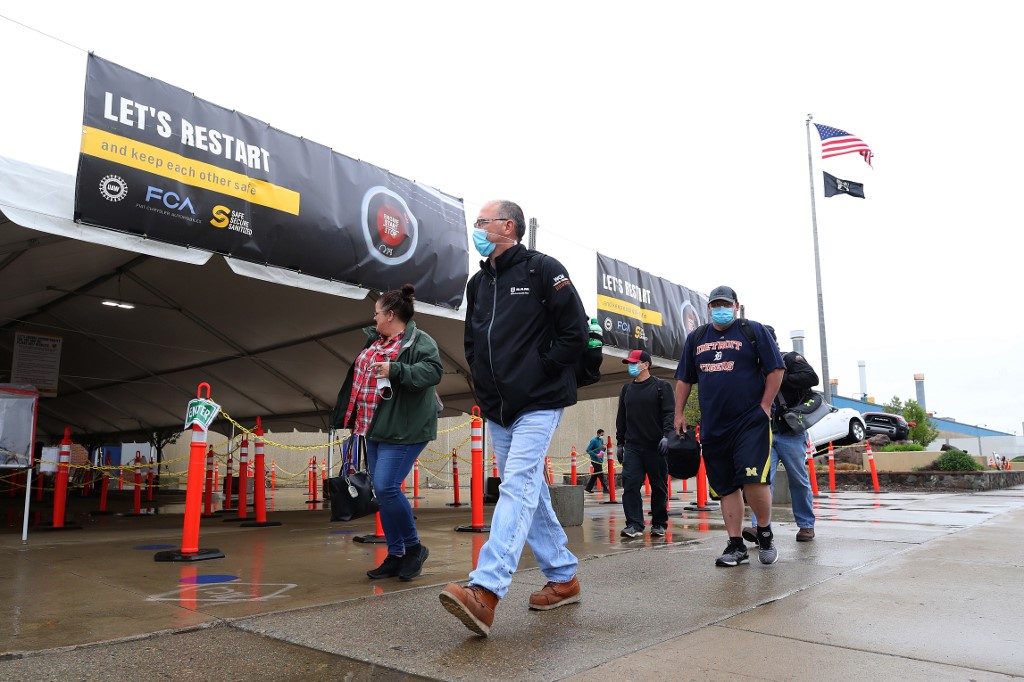SUMMARY
This is AI generated summarization, which may have errors. For context, always refer to the full article.

WARREN, USA – Two months after effectively freezing American auto manufacturing, Detroit’s “Big Three” on Monday, May 18, began to get back to business with masks, temperature checks, and physical distancing protocols to try to prevent coronavirus outbreaks.
Some hourly workers have expressed concerns about the risks of assembly line activity, where staff traditionally have worked side-by-side. But automakers say they will be able to work while practicing physical distancing and taking other measures to protect workers.
The resumption brings a burst of fresh economic activity across states in the midwestern United States, a key swing area in the upcoming elections.
President Donald Trump is set to visit a Ford plant in Michigan later this week that has been building ventilators and other medical equipment during the pandemic.
The relaunch also comes as the US economy continues to bleed millions of jobs in the wake of coronavirus shutdowns that have dimmed expectations for auto sales in 2020, although industry analysts have seen signs of a partial recovery in recent weeks.
The Big Three closed down in mid-March under heavy pressure from union officials following outbreaks at some facilities.
Balancing health, economy
United Auto Workers spokesman Brian Rothenberg said the labor organization was closely monitoring the situation.
“It’s still early but I haven’t heard of major incidents, and staffing appears to be at or above estimates as people go through protocols,” Rothenberg said.
At the Fiat Chrysler Automobiles (FCA) plant in Warren, Michigan, where the Ram 1500 pickups are built, workers arrived in the rain at 5 am for the first shift.
Laruante Gary, a production operator at the plant, said keeping 6 feet apart can be “very difficult” at times when there are 1,000 workers at the facility.
“I feel a little nervous,” Gary said. “I think it’s a little soon but I thought we’re all going to get through it.”
As they reported to work at plants manufacturing Chevrolet, GMC, and other models, General Motors (GM) took the temperature of employees and provided face masks and other personal protective equipment, company spokesman Jim Cain said.
Automakers have disinfected work stations, revamped spaces, staggered shift times, and installed soap and cleaning equipment throughout the factories. They will also test employees who show COVID-19 symptoms.
GM chief executive Mary Barra said earlier this month that the company would resume production “in a very cadenced and thoughtful way,” with just one shift before adding more.
Ford set return-to-work dates for several plants for the week of May 18, while listing a few factories that would not resume until the week of May 25.
At FCA, about 12,000 employees returned to work on Monday, the company said, while a GM spokesman said all but 4 of its US plants had resumed operations, with the remaining factories to come back within the next two weeks.
Ford chief executive Jim Hackett said that the company’s confidence in the restart stemmed from the success of operations in Europe and Thailand, where workers have been brought back without sparking COVID-19 outbreaks.
“We have not found an infection in any of those factories,” Hackett told NPR, adding that the crisis had forced a rethink of plant operations.
“Prior to COVID, we would put more than one person in a vehicle as it was moving down the line as they were adding items,” he said. “We’ve rechoreographed that so it’s not going to happen.”
Hit to productivity?
GM’s target is to return to pre-COVID 19 production levels in 4 weeks. Both Ford and FCA have avoided giving a timeframe.
Analysts warn productivity will be lower, at least at first, due to the physical distancing measures as well as the hit to global supply chains.
Companies may have trouble importing parts from countries still impacted by the coronavirus, or from the resulting backlog once things open.
“The new normal may be a lower volume than we did before,” said Charlie Chesbrough, a senior economist at Cox Automotive, pointing to backlogs at Chinese ports.
Moody’s last week slashed its outlook for 2020 US auto sales to a decline of 25% from the prior 15% projected drop.
US car sales data from the last few weeks, while still weak, has improved significantly from late March, said Chesbrough. Even in a broadly weak market, US consumers could have trouble this summer finding popular truck and sport utility vehicles due to limited production.
“There may be only white vehicles out there, or not the right trim level,” Chesbrough said, adding that COVID-19 hit both auto supply and demand. – Rappler.com
Add a comment
How does this make you feel?
There are no comments yet. Add your comment to start the conversation.